My 27 new best friends and I will be saying goodbye early this morning as they head back to the United States, leaving at 3:30 am for Munich and thence to Chicago. Perhaps it was appropriate that we spent half the day together, viewing still more of the attractions that bring 10-15 million visitors to Istanbul, then the other half of the day in a free for all, doing some of the other things that bring 10-15 million visitors to Istanbul.
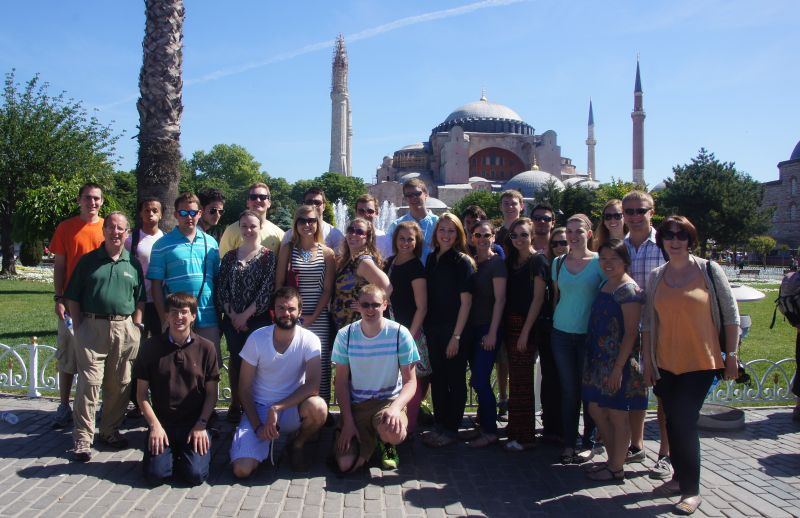
All three of the sites we visited reflected the past of the city. The visit to Aya Sophia represented the oldest site. The church, built on a previous church site, was constructed in the 6th century during the reign of Justinian, who was responsible for many of the great works (and great expenses) of the Byzantine Empire; during his reign, the boundaries were at their greatest, including the reconquest of the Western Empire, i.e., Rome. Justinian (and his consort, the one- time courtesan, Theodora) were, for example, builders of the wonderful chapels at Ravenna, Italy, with their likenesses. Justinian’s efforts in Istanbul, however, led to the creation of the 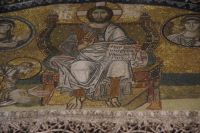 largest church in the world at the time. Emperors received their crowns in ceremonies in the Church, which was one of the last holdouts in 1453. Of course, after the conquest, Mehmet changed it to a mosque, plastered over the mosaics, and for the next 400 years, Aya Sophia remained a mosque.
largest church in the world at the time. Emperors received their crowns in ceremonies in the Church, which was one of the last holdouts in 1453. Of course, after the conquest, Mehmet changed it to a mosque, plastered over the mosaics, and for the next 400 years, Aya Sophia remained a mosque. 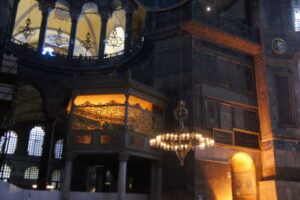 During the Republic, Ataturk turned it into a museum, partially Christian, partially Muslim. Some of the mosaics survived, but so did the mihrab and the camel skin panels praising Mohammed and Allah. It remains, for me, one of the most impressive sights in Istanbul, partly for what it has meant over time. When you come to see it, it may have more of its original features; about half the building now is being renovated.
During the Republic, Ataturk turned it into a museum, partially Christian, partially Muslim. Some of the mosaics survived, but so did the mihrab and the camel skin panels praising Mohammed and Allah. It remains, for me, one of the most impressive sights in Istanbul, partly for what it has meant over time. When you come to see it, it may have more of its original features; about half the building now is being renovated.
Across from Aya Sophia, we visited a still-used mosque, from the 17th 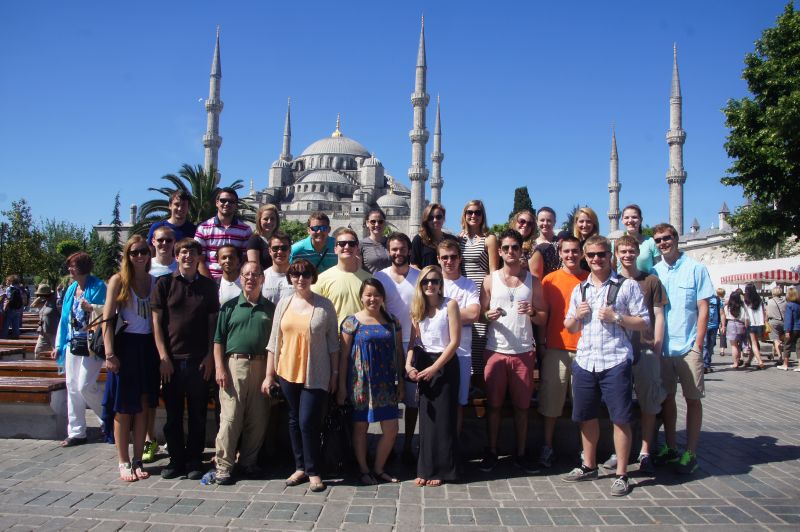 century. Western guidebooks usually call it the Blue Mosque because ofthe plethora of blue tiles in the stunning inside, but it’s really the mosque one of the sultans commissioned to be built (as our guide said most mosques were) in 7 years. Indeed, the sultan ordered the mosque to have 6 prayer towers (minarets), because, at the time, only the mosque in Mecca had 6 minarets; most have only four, but the sultan of Turkey, Defender of the Faith, was, I think, at the time the overlord of Saudi Arabia, and wanted to demonstrate his authority. Enraged conservatives added three minarets, and now the mosque in Mecca has nine, but the Blue Mosque is the only one with 6.
century. Western guidebooks usually call it the Blue Mosque because ofthe plethora of blue tiles in the stunning inside, but it’s really the mosque one of the sultans commissioned to be built (as our guide said most mosques were) in 7 years. Indeed, the sultan ordered the mosque to have 6 prayer towers (minarets), because, at the time, only the mosque in Mecca had 6 minarets; most have only four, but the sultan of Turkey, Defender of the Faith, was, I think, at the time the overlord of Saudi Arabia, and wanted to demonstrate his authority. Enraged conservatives added three minarets, and now the mosque in Mecca has nine, but the Blue Mosque is the only one with 6.
 Not many noticed it, and our guide did not point it out, but connecting the two religious institutions was what had been the center of Byzantine social life, the Hippodrome. At one time, it could seat 100,000 people, and was THE place for the Reds, Greens, and Blues and Whites to cheer on their teams, much as soccer fans still do today. There’s not much left from the Byzantine days, save for a few obelisks (the Romans brought them to Rome, too).
Not many noticed it, and our guide did not point it out, but connecting the two religious institutions was what had been the center of Byzantine social life, the Hippodrome. At one time, it could seat 100,000 people, and was THE place for the Reds, Greens, and Blues and Whites to cheer on their teams, much as soccer fans still do today. There’s not much left from the Byzantine days, save for a few obelisks (the Romans brought them to Rome, too).
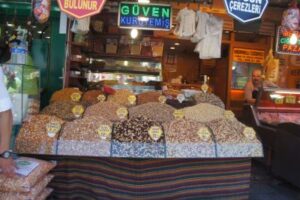 The other site was a visit to a 15th century business location, the so-called “Spice Market,” where merchants from Egypt and other exotic places brought their saffrons, teas, and other foodstuffs that makes Istanbul a far more interesting place for me to eat than, say, London. This was where I parted company with the group and began my own “free for all,” because there were a few places I thought I would hit because they were not on my after-trip itinerary.
The other site was a visit to a 15th century business location, the so-called “Spice Market,” where merchants from Egypt and other exotic places brought their saffrons, teas, and other foodstuffs that makes Istanbul a far more interesting place for me to eat than, say, London. This was where I parted company with the group and began my own “free for all,” because there were a few places I thought I would hit because they were not on my after-trip itinerary.
Note: I did not realize it at the time, but this was to be my last trip with students. As you’ll see from the timeline, that enabled trips to places I would never have gone with students–Cuba, Latin America, and Africa. But what a wonderful way to close out almost twenty years of opening young minds to the world.